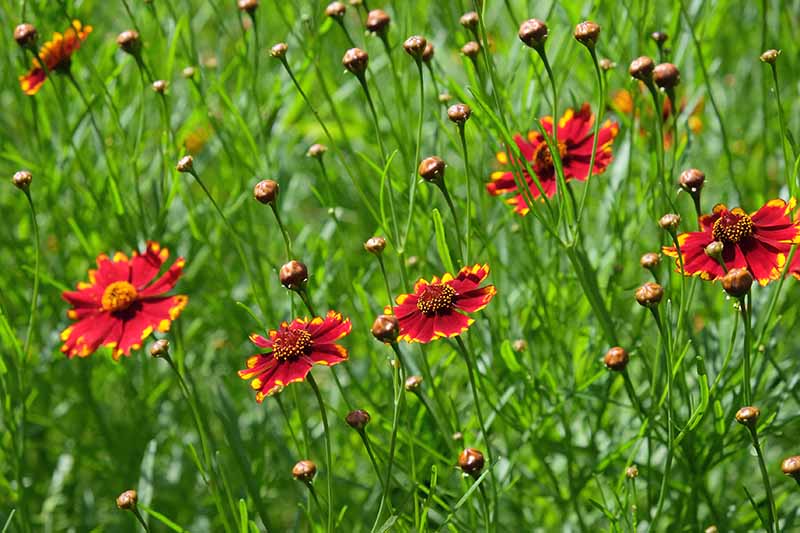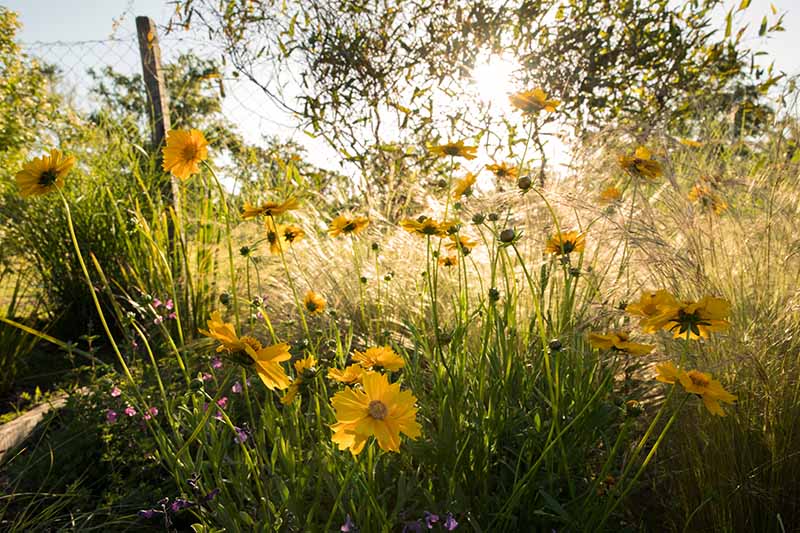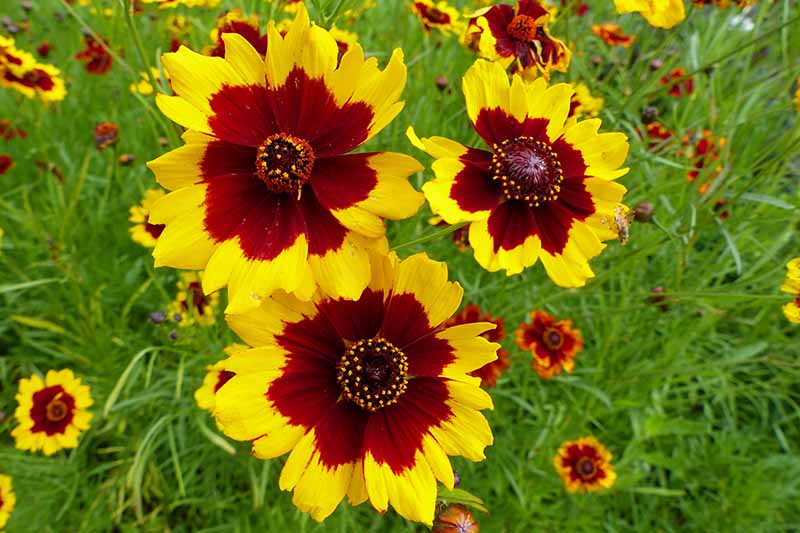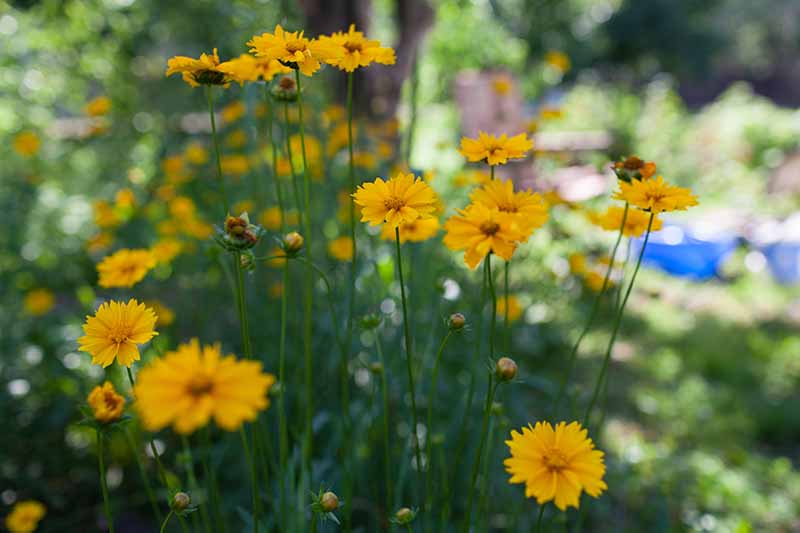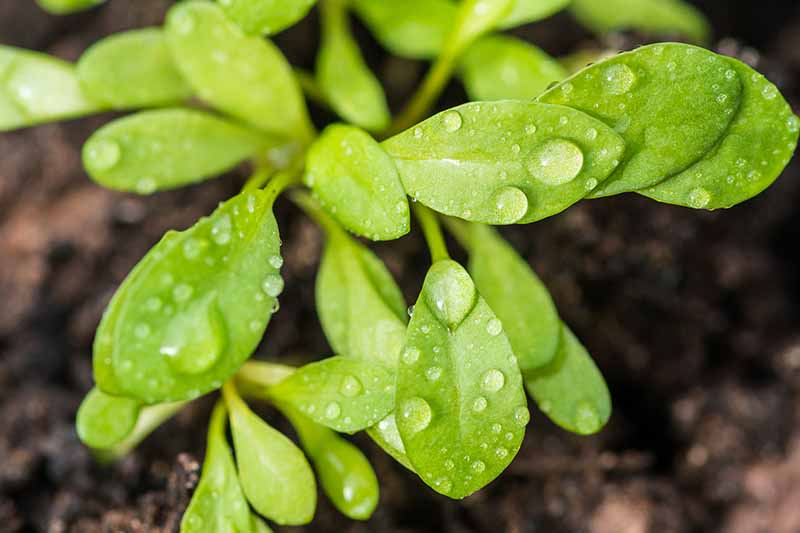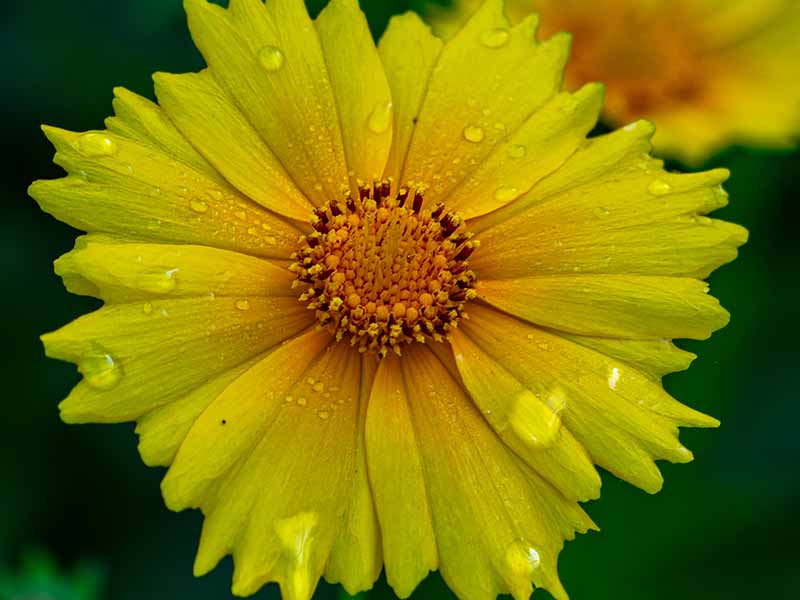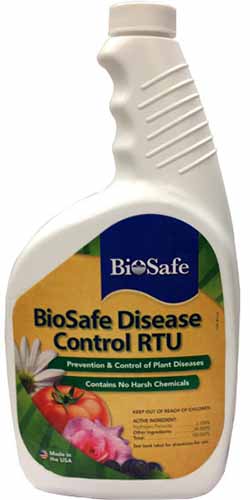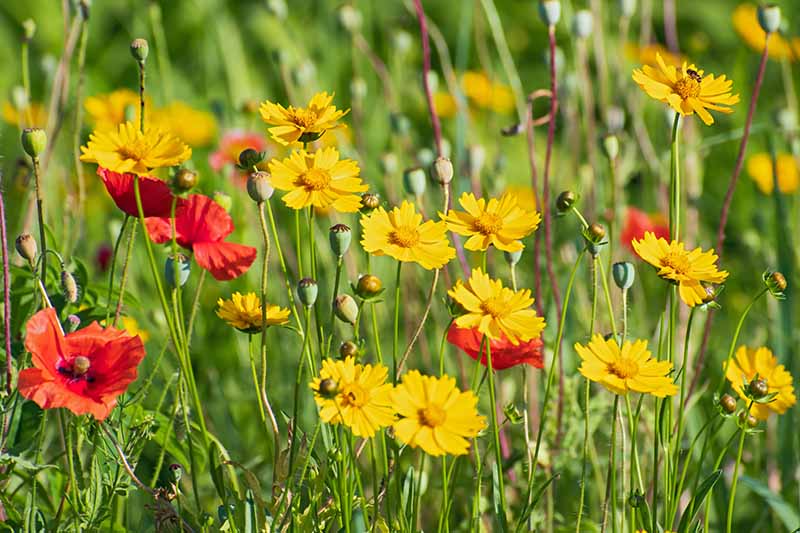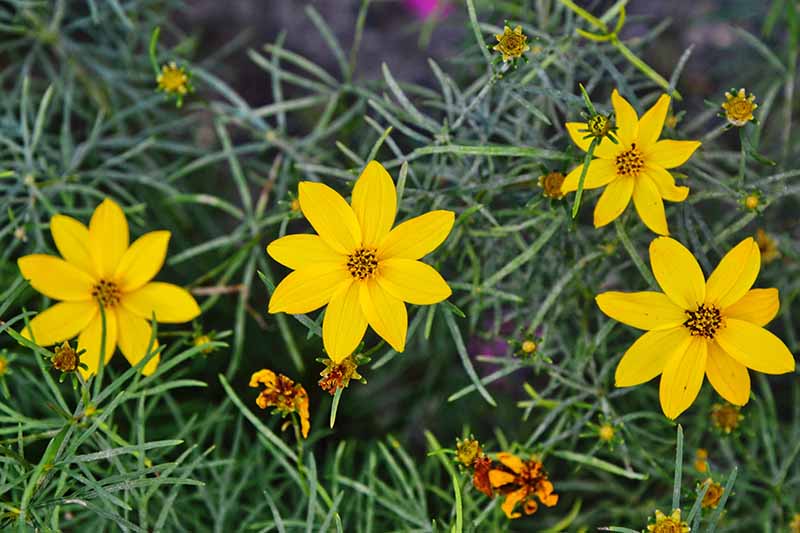It comes from a combination of two Greek words: “koris,” meaning bedbug, and “opsis,” meaning view. Paints a pretty picture, doesn’t it? Well, while the etymology may not be lovely, the flower certainly is. Growing natively throughout the Americas are varieties in bright and pale yellow, white, red, and all sorts of combinations thereof. Most are characterized by attractively toothed petals. We link to vendors to help you find relevant products. If you buy from one of our links, we may earn a commission. Let’s learn more about this prairie and woodland beauty, also sometimes known as “calliopsis.”
What Is Coreopsis?
You may have guessed how this member of the aster family, Asteraceae, got its common name. Its small, dark seeds are said to look like ticks. Tickseed can be a perennial or an annual, depending on the variety and where it is grown. These plants love warm weather, but most varieties grow well in USDA Hardiness Zones 4-10. This upright plant can grow to be as tall as four feet, but many varieties are about a foot tall, and they can spread anywhere from 12 to 36 inches. It sprouts its flowers on wiry stems above the foliage. Different varieties bloom at different times, but in general you can count on this generous plant to produce a profusion of flowers from early spring until late fall. The blooms attract a variety of pollinators, including bees, butterflies, and hummingbirds.
Cultivation and History
True to its sunny disposition, coreopsis means, “always cheerful” in the Victorian-era language of flowers. The National Garden Bureau named 2018 the “Year of the Coreopsis,” praising its sunny beauty, propensity for lending itself to creating gorgeous hybrids, and prolific growth, especially in midwestern, southern, and southeastern states. C. tinctoria, an edible species also known as “plains coreopsis,” has long been used by Native American people for dye and as an herbal remedy. The Lakota people use it for tea. Traditional Cherokee medicine uses an infusion of the roots to help treat diarrhea. Cherokee, White Mountain Apache, and Zuni people make dye with the flowers, and traditional Navajo medicine enlists the plant’s help in treating various reproductive issues. This helpful bloom even holds the distinction of being the state wildflower for both Florida and Mississippi, which isn’t terribly surprising considering that in 1891, the J. T. Lovett Company wrote of the genus, “[it] is one of the finest hardy plants grown….a wonderfully profuse bloomer and most excellent for bouquets.” Oh, and it’s nontoxic to animals too, making it an ideal addition to a wildflower yard or flower garden for animal-lovers and pet owners everywhere. While this attractive bloomer most definitely has a preference for full sun, it is considerably less particular about soil type. It will grow in sandy or loamy soil, or even clay, and acidic or slightly alkaline soil, though the ideal pH should be between 5.5 and 6.5. It does not do well in rich, thoroughly amended soil. So save your compost for other plants and let coreopsis make do with what’s available.
Propagation
The easiest way to propagate this flower is from seed. Or, just buy a plant from a nursery for transplanting to add instant color to your flower garden!
From Seed
You can either sow seeds indoors six to eight weeks before you’d like to transplant them outside, or direct-sow them outdoors. We’ve provided instructions for both methods below.
Starting Seeds Indoors
If you live anywhere in Zones 4-7, you might just want to get a head start on your bright, lovely tickseed. You’ll be able to transplant seedlings outside two weeks after the average last frost date in your area. So six to eight weeks before that date, it’s time to get them going indoors. To sow indoors, prepare a seedling tray with fresh seed starting mix. If you have a heat mat and a humidity dome, these can help to speed up germination. In each cell, place two tiny seeds just a scant eighth of an inch deep in the potting mix, since these seeds need light to germinate. Spray each seed cell with water, cover the whole tray with a humidity dome, and set the tray on a heat mat near a window that receives at least six to eight hours of sunlight. If you don’t have any sunny spots for your coreopsis seeds, you may want to invest in a grow light. If you opt to use one, make sure you keep it just an inch or two away from the surface of the soil, adjusting it as the seed germinates and the young plants begin to grow. Since grow lights aren’t as strong as the sun, provide your coreopsis seeds and seedlings with 12-14 hours of artificial light each day. Using a misting bottle, keep the soil moist, but not waterlogged, and the temperature surrounding the seed tray at 55 to 75°F, which is the ideal germination temperature. Seedlings should emerge within three to four weeks. Keep them evenly moist and warm, and keep those grow lights trained on them as they emerge and grow true leaves. Once your seedling has two true leaves, pinch off the smaller seedling if both seeds in each cell germinated. You’ll be able to transplant them into the garden, as described below, after all risk of frost has passed.
Sowing Seeds Outdoors
You’ll need to sow seeds outside two weeks after your area’s average last frost date, or ideally, when the earth has warmed up to between 55 and 75°F. Choose a location that receives at least six to eight hours of full sun every day. For a pleasing, field-of-wildflowers aesthetic, scatter seeds in your flower garden and then toss a very thin layer of soil on top of them. Water until the soil is evenly moist, and keep it moist until germination occurs. Before long, you’ll have a cluster of delightful blooms to gaze at whenever you walk outside. If you don’t want the plants to have that crowded, grown-in-the-wild look, thin them out until there are about 12 inches of space between each one. They’ll probably do fine if they’re closer together than this, but this is the recommended spacing. For a more organized look in a flower bed, sow individual seeds 12 to 36 inches apart, depending on your preference, and water evenly.
Transplanting
Two weeks after your average last frost date, you can transplant your young plants to your yard or garden. This is also the ideal time to transplant those purchased at a nursery. First, harden the plants off. Every day over the course of a week or 10 days, bring them outside for increasing amounts of time until they’re spending the entire day out in the elements. Then prepare a hole (or several) in a sunny spot in your yard or garden. Make the hole as deep and wide as the root ball you’ll be transplanting. Space the holes about 12 to 36 inches apart, depending on your preference and on the cultivar you’re growing. Gently ease the hardened-off plants out of their nursery containers and place them inside their holes. Water deeply and thoroughly. Continue watering regularly for the next couple of weeks, providing about an inch per week if the weather doesn’t take care of it for you. Not sure how much rain you’re getting? You can keep track of the local precipitation with a rain gauge.
How to Grow
As the plants mature and become established, they will tolerate drought conditions, but they’ll produce more flowers with regular, deep waterings. Every week, or whenever you check the soil and feel that the top inch or two of soil is dry, water deeply. To help retain moisture, put down a three- to four-inch layer of mulch, such as bark chips, leaves, grass clippings, or straw. Coreopsis does just fine without fertilizer and thrives in poor soil. Neglect these deer-resistant plants and they will still reward you with attractive flowers. And, as a happy bonus, they reseed quite copiously. If you’re growing tickseed in a container, which should be at least eight to 10 inches deep and wide, make sure it’s in a location that receives at least six to eight hours of direct sun. The container should have drainage holes to keep water moving through the soil and out the bottom, as coreopsis doesn’t like having wet feet. Use a well-draining potting soil, too. You’ll also want to check the moisture level of the top inch of soil more frequently if you’re growing your plants in a container, as the soil will dry out faster.
Growing Tips
Plant in a full sun location.Water deeply whenever the top inch or two of soil dries out in the absence of rain.Cut spent blooms away regularly to encourage new flowers.
Pruning and Maintenance
To keep tickseed flowering, you must deadhead, or cut away spent blooms. This will also help keep them from going to seed and spreading too quickly. But that’s about all the attention you need to pay to these hardy beauties. If you don’t deadhead in time, you might have to pick unwanted volunteers that have spread beyond the scope of your flower garden. When the growing season ends and you’re preparing coreopsis for winter, resist the urge to cut the stems back to the ground. Tickseed is a short-lived perennial and cutting it back all the way to the ground can negatively impact its health, turning it effectively into an annual instead. You’ll want to add a new layer of mulch before wintertime, too. Learn how to prepare coreopsis for winter in our guide.
Cultivars to Select
While there are more than 30 naturally occurring varieties of coreopsis in the United States, commercial breeders have developed numerous attractive cultivars. Here are a few of our favorites:
Managing Pests and Disease
With proper care, there aren’t many issues that can take down a coreopsis. But sometimes, despite your best efforts, you might have issues with your dreamy tickseed. With its thready leaves and single-flowered blooms, ‘Creme Brulee’ softens the overall color in your flower garden and would look amazing against a green, red, or brown-walled house. ‘Creme Brulee’ ‘Creme Brulee’ blooms from late spring all the way through the summer, grows 15 to 18 inches tall, and spreads 18 to 24 inches. Hardy in Zones 5-9, this one’s ideal for those of you in warm, sunny climes. Find plants in one-gallon containers from Nature Hills Nursery.
Early Sunrise
C. grandiflora ‘Early Sunrise’ is a particularly attractive cultivar, exhibiting bright yellow, semi-double blooms. This Royal Horticultural Society award winner (1993) is hardy in Zones 3-9, grows 24 inches tall, and spreads 15 to 18 inches. ‘Early Sunrise’ The plants bloom from June to September, giving you plenty of time to admire the bright blossoms. Find packets of 150 seeds available from Burpee.
UpTick™ Cream and Red
Do you love a mix of the bold and the subtle? Look no further than this hybrid, ‘Cream and Red,’ a selection from the popular UpTick™ series, bred by Darwin Perennials. UpTick™ ‘Cream and Red’ The understated cream color on the outer part of the petals is delightfully interrupted with a bold burgundy center. This hybrid grows and spreads 12 to 14 inches and is hardy in Zones 5-9. Find plants in containers available from Burpee. Check out our supplemental guide, “17 of the Best Coreopsis Varieties,” to find the right cultivar for your yard or garden.
Let’s take a look at the most troublesome pests and diseases to keep an eye out for.
Pests
As far as pests go, there are three potential threats:
AphidAster leafhoppersCoreopsis beetles
Aphids (Aphidoidea spp.), green or yellowish insects just two to four millimeters in size, will suck juice from every part of your plant. They weaken the tickseed’s overall health, but they’re fairly easy to get rid of. Just spray the affected plants with a garden hose to wash the aphids off, and then apply a neem oil spray or insecticidal soap to the plants to prevent reinfestation. Aster leafhoppers (Macrosteles quadrilineatus) are bad news because they spread the phytoplasma (aka small bacterial parasites) that causes aster yellows, a leaf-killing disease that eventually destroys the entire plant. The bacteria that causes aster yellows only survives inside the body of aster leafhoppers or in the veins of susceptible plant leaves. Aster leafhoppers are brownish-green insects that are about four millimeters long and resemble grasshoppers. They suck the sap of affected plants, ingesting the phytoplasma that causes aster yellows. Then, they find coreopsis, a plant they love, and release the bacteria into the plant as they feed. The good news is that, if you can prevent or quickly control any aster leafhopper infestations, you can likely prevent aster yellows. To lessen the likelihood of leafhopper infestation, avoid planting cereal crops, carrots, celery, or flowers in the aster family near your coreopsis patch, as these are all feeding and egg-laying grounds for aster leafhoppers. Keep the area around your flowers well weeded, as common weeds like dandelions can harbor leafhopper colonies. If you see any of the little pests, manually remove and destroy them and the plants they were on. Spray the entire affected area and the surrounding plants with neem oil or insecticidal soap to help prevent re-infestations. Coreopsis beetles (Calligrapha californica) are about one-fourth of an inch long and resemble ladybugs, except that they have white stripes instead of black dots. These pernicious beetles are rare, but when they appear, they wreak havoc. They eat leaves, leaving obvious holes and jagged cuts in the foliage, as though a small child has gone through and taken a few bites. If you see them, remove and dispose of them far, far away. (Or, er, get rid of them, if you know what I mean.) Spray your plant with insecticidal soap or neem oil according to package instructions and check it for beetles morning and night until you stop seeing any new beetles for at least three days in a row. Keep checking the plants a couple times a week to stay ahead of any new, unwanted visitors.
Disease
As far as diseases go, here are the top ailments to watch out for:
Aster yellowsBacterial leaf spotDowny mildewPowdery mildew
Aster yellows, the aforementioned disease spread by aster leafhoppers, essentially drains the plant of life from within, causing leaves and petals to fade and curl, and eventually die. You can learn more about this malevolent disease in our guide to preventing aster yellows and slowing infestations. There is no known way to treat or cure it. Other diseases to watch for are downy mildew (caused by Plasmopara halstedii), which makes brownish-black spots and fuzzy white mildew develop on the leaves, and powdery mildew (Sphaerotheca macularis), which shows up as a powdery coating on the foliage. BioSafe Disease Control To treat bacterial leaf spot, remove affected foliage and spray the plant with a bactericide, like this one from BioSafe, available from Arbico Organics. Remove affected plant tissue and apply a copper fungicide to as-yet-unaffected areas to help prevent further spread. Learn more about how to control powdery mildew in our guide. Maintaining ideal growing conditions goes a long way toward preventing diseases from developing in the first place. Avoid overhead watering to keep the leaves free of unnecessary moisture, for example, regularly deadhead, and even cut away a few blooms to bring inside to promote good airflow.
Best Uses
If you want to turn your entire yard into a wildflower garden, coreopsis is an excellent choice. Mix it with salvia and poppies for a stunning field of color. Tickseed also makes an excellent border all summer long. Or, grow it in a tidy flower garden to add a cheery yellow anchor to a bevy of colorful blooms. You can also grow it in containers and set it on a sunny patio, making a bright welcome for any guests to your home. Whenever you feel the need for some indoor cheer, cut a few blooms and bring them inside. Add some homemade fresh cut flower food, put them in a vase, and change the water regularly, and they’ll last for up to a week. With an artist’s palette of colors to choose from, you’re sure to find a variety that complements your landscape. Setting aside its queasiness-inducing common name, tickseed is certainly a plant you should consider for your garden. What do you think about this American native? Willing to try it in your yard? Share your thoughts in the comments section below. And for more information on growing wildflowers in your garden, check out these additional guides next:
15 of the Best Native Wildflowers for the US and Canada11 Native Blue Wildflowers for the GardenHow to Grow and Care for Prairie Onion How to Grow Blackfoot Daisy




